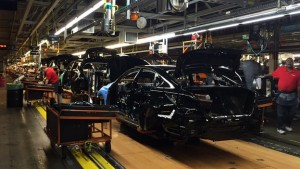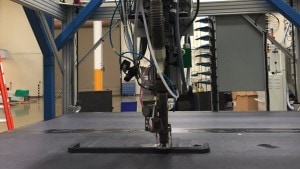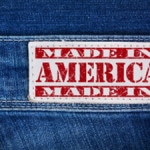US Manufacturing: Return of The ‘Made in America’ Label?
Nashville, Tennessee, the home of country music, is now becoming known for its car production.
Is American manufacturing undergoing a renaissance? Manufacturing jobs have come back in force, and advanced industries are leading the US recovery, according to the Brookings Institution.
Since 2010, nearly 800,000 manufacturing jobs have been created, reversing a decade-long trend where the industry lost a staggering one-third of its workers. I went to the US to find out if there was a revival of “Made in America”.
The song “Let’s give them something to talk about” wafts through the air on Broadway in downtown Nashville.
Sign after sign in neon lights announce the names of the bars and restaurants that line both sides of the street, most with their own live country music bands playing to crowded rooms full of diners chowing down on southern barbecue.
But that’s not why President Obama came to Tennessee last month. The state is leading the revival of manufacturing in America. The home of country music and southern barbecue is now surprisingly being called the new Detroit.
The largest car factory in North America, owned by Japanese firm Nissan, is located here and not in Michigan. Nissan recently tripled its workforce in the plant, which exports to over 60 countries around the world.
US Manufacturing – A ‘Perfect Storm’
Factories like the Nissan plant are hiring and expanding. But the factories of today are nothing like the shop floors of the past. Robotic arms not only assemble the cars, but robots drive supplies around the factory floor that is an astounding 5.3 million square feet.
I was driven around in a golf cart since it was a mile from the factory entrance to the stamping machine churning out car bonnets.
Nissan recently decided to site more of its car production in the US. It’s not just foreign companies. After decades when production was leaving the US, American companies like Stanley Black & Decker, which has been manufacturing in countries like China, are returning. It recently produced its first power tool in the US in over 25 years.
An almost perfect storm of factors is boosting American manufacturing. The shale revolution has lowered energy costs and made the US look competitive again.
Rising wages in emerging markets like China is another reason. Black & Decker says it now costs the same to produce in America as it does in China once logistics and transport costs are taken into account. Plus, the US has maintained its position as the technology leader, so productivity is high.
Manufacturing – Skills Shortage
That’s why President Obama and Vice President Joe Biden were in Tennessee. There’s a long history of innovation here. Eastern Tennessee is where the once-secret city that developed the atomic bomb is located.
The president announced federal funding to support advanced industry, those with a high proportion of research and development spending, and STEM – science, technology, engineering and mathematics – workers.
The funding for Oak Ridge National Laboratory supports the development of 3-D printing or what’s called additive manufacturing. The husk of a 3-D printed car sits next to a machine that doesn’t look much like a printer. A robotic arm secretes layer upon layer of plastic to form a section of a car body.
Techmer is the company working with Oak Ridge to create the plastics that make the car body strong enough to withstand road stress.
The smell of melting plastic and the loud whirling of machines reminded me that even though the products are high tech, it’s still a manufacturing plant.
But will Americans really contemplate going back to work on the factory floor? The companies all worried about a shortage of skilled workers. So, I went to meet students from the University of Tennessee.
They told me they didn’t see their future in manufacturing. Some wanted to finance those plants while others said that they weren’t good enough at mathematics to work in advanced industries.
They all agreed that manufacturing has an image problem – it might have been a good job for their parents’ generation, but it was not for them.
Manufacturing – Different Dreams
After all, the US economy is almost entirely made up of services like the music industry, restaurants, and banking. Manufacturing accounts for only around 12% of GDP, down from nearly 30% in 1950. De-industrialisation is associated with a loss of good blue-collar jobs, rising inequality and less innovation.
America wants to produce more after a devastating financial crisis and also address wages that have been stagnant for decades. So advanced manufacturing could help. But will this revival last? And can it if manufacturing is no longer part of the American Dream?
Walking along the neon-lit streets of Nashville, the quest for stardom has brought many hopefuls to the town that launched musicians and singers like Taylor Swift. But in Oak Ridge National Lab, 100 students gathered after school to chase a different dream: they were competing to build the best robot.
One of them put up a sign that said Made in America – but in Chinese. It’s their way of signaling that the Made in China labels in English on their clothes and electronics will soon face some serious competition.







Thanks for a great post!
The not-for-profit Reshoring Initiative can help.
The not-for-profit Reshoring Initiative’s free Total Cost of Ownership software helps corporations calculate the real P&L impact of reshoring or offshoring. In many cases, companies find that, although the production cost is lower offshore, the total cost is higher, making it a good economic decision to reshore manufacturing back to the
U.S. http://www.reshorenow.org/TCO_Estimator.cfm
FSM has been growing steadily over the past 3 years and we can testify to the resurgence and progress of American Manufacturing. Go team USA!